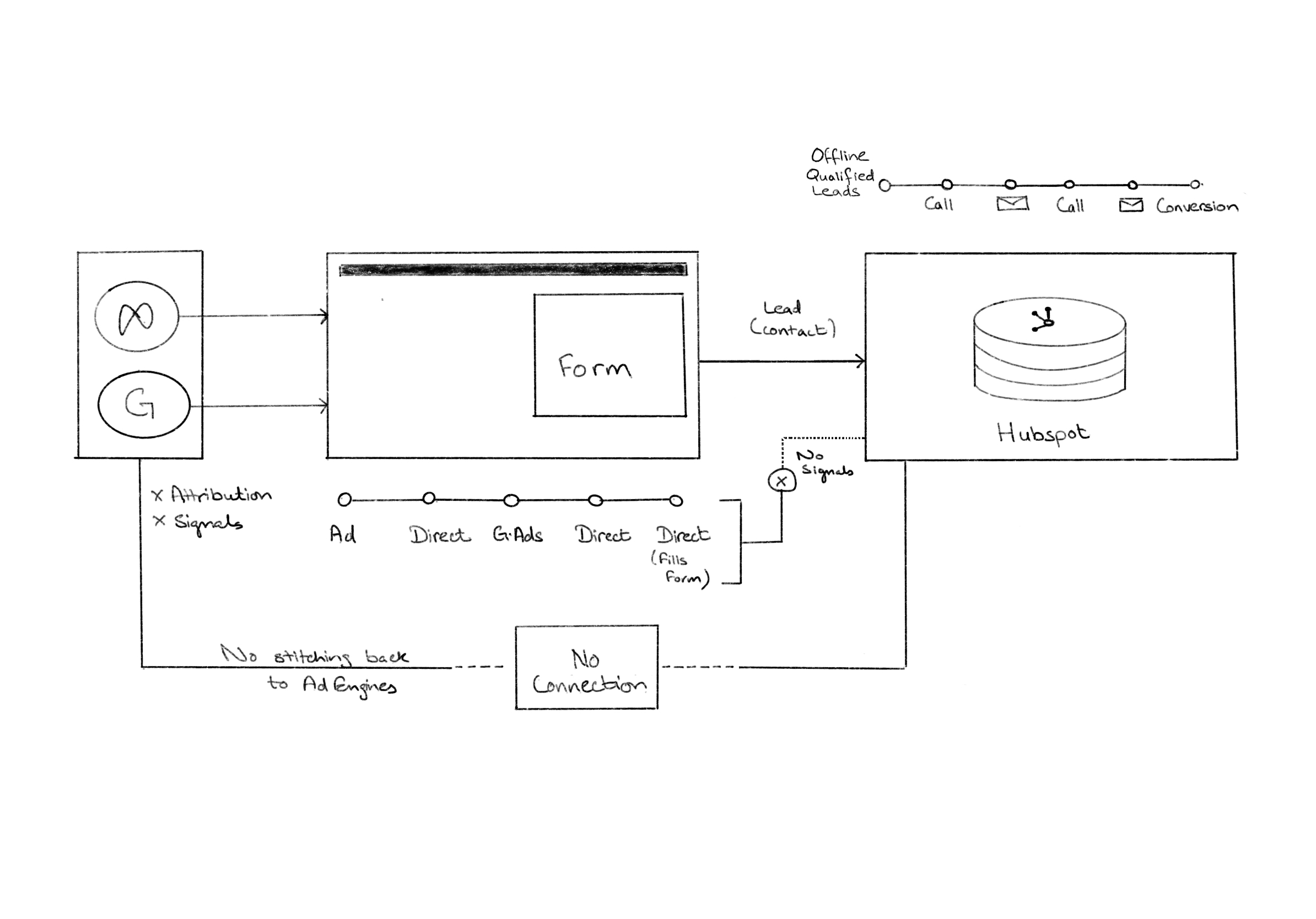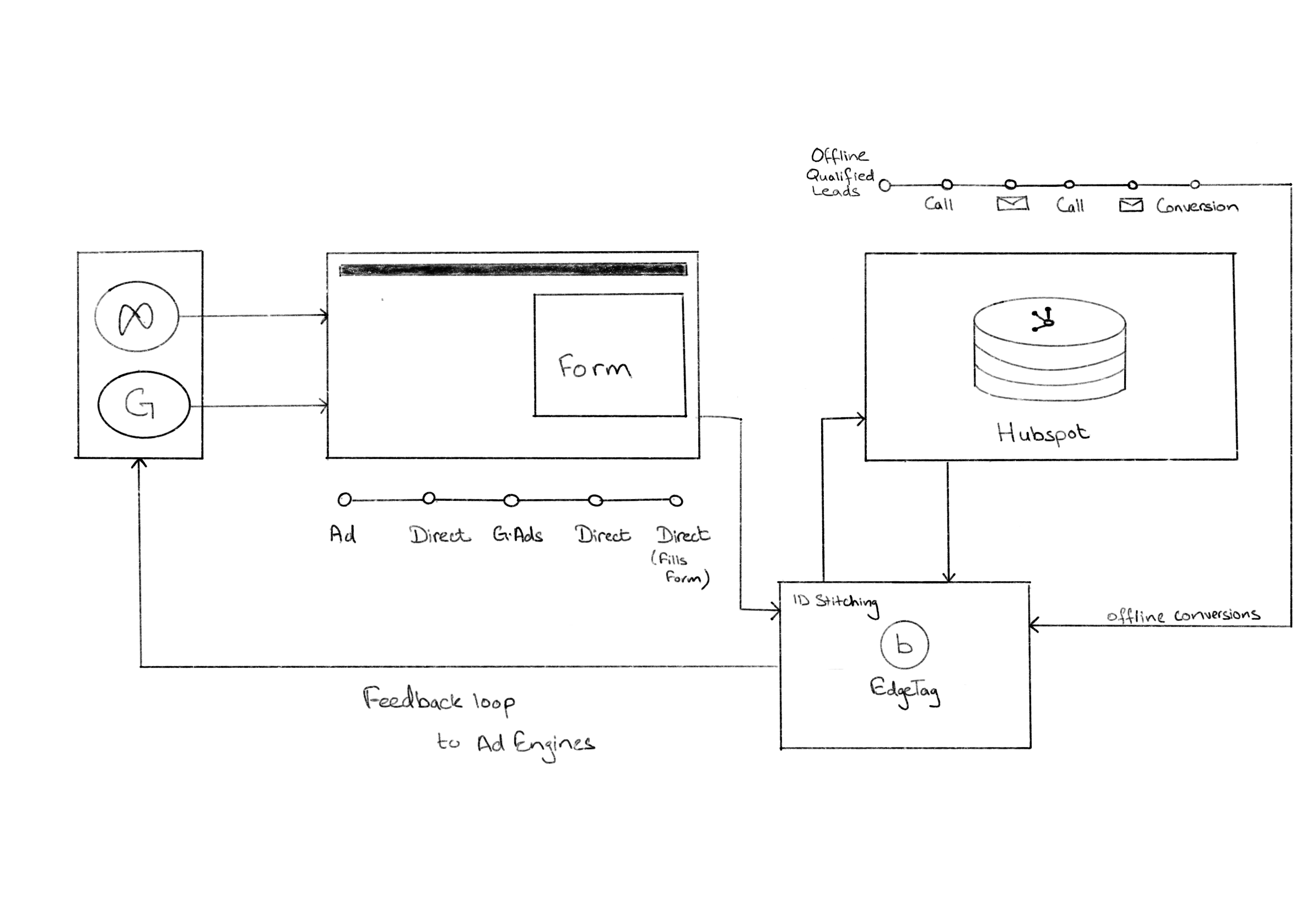Marketers are under constant pressure to deliver results fast —but the reality is, technical bottlenecks, silo’d teams, different platforms, and dev queues can stifle even the most sophisticated lead gen stack.
Many marketing professionals feel stuck: they have big visions, but don’t always have the coding skills or budget to bring those ideas to life quickly. What if there was a way to build your ideal lead generation stack, integrate your favorite tools, and automate complex workflows, all without a single line of code?
In this post, we’ll show how the rise of no-code platforms is reshaping what’s possible for results-driven marketing teams.
Most marketers today rely on platforms like WordPress, Webflow, or similar to build lander or websites and collect leads. Once captured, these leads are then handed off to popular CRMs like HubSpot (or comparable systems), which take care of the next steps:
Data Cleaning & Enhancement: The CRM standardizes and enriches lead data to minimize errors and duplicates, ensuring cleaner pipelines and more accurate records. Lead Qualification: Automatic rules or AI-assisted tools score leads based on engagement and fit, distinguishing between cold, warm, and hot opportunities for more focused follow-up. Nurture & Close: Qualified leads get routed into targeted workflows or sequences—email nurturing, task assignments for sales reps, and often triggered updates to the CRM and internal communications—helping move prospects toward conversion.
This standard stack has become the backbone of digital marketing operations, providing predictable, scalable infrastructure for managing lead funnels from capture to close, with HubSpot’s automation and integration features acting as the system of record and engagement.
However, a critical missing link persists: the lead generation engines (Meta, Google, Inbound, etc) that drive initial conversions rarely receive feedback about which leads were ultimately bad, lost, or successfully converted. This disconnect prevents marketers from optimizing spend, hyper focused targeting, and creativity for scale and quality.
iOS 14.5 is not just a Merchant problem
It’s a growing problem made worse by the post-cookie era—after changes like iOS 14.5, tracking user journeys across touchpoints has become both harder and less accurate as engagement on site also never reaches CRM and the lead conversion never gets stitched back to all touch points that drove the lead in the first place.
Core Issue at hand
Today’s standard workflow—with Webflow, WordPress, or similar tools collecting leads, and a CRM like HubSpot managing them—means front-end systems rarely learn what happened after the initial handoff. Attribution models and analytics that depend on third-party cookies are losing value, and server-side signals or APIs like Conversions API are emerging as new alternatives, but they often still don’t solve the bi-directional feedback gap at the source.

For lead gen marketers, this has significant consequences: Incorrect Attribution: Optimizing for quantity over quality, without knowing which sources and campaigns actually delivered closed deals. Underperforming creative and targeting: because there’s no feedback loop on what resonates with ideal prospects. Scaling challenges: as data privacy limits traditional tracking, making it difficult to connect initial engagements to final outcomes.
Fixing the stack;
That’s where zero-code ID stitching becomes essential to remove dev chaos, organizational chaos, and creating a simple funnel view to your customer’ journey.
Someone needs to connect all the dots between site and CRM—feeding outcome data (like lead status changes: converted, bad, or lost) directly back into the lead generation engine. That’s exactly the gap addressed by Blotout. With Blotout, your WordPress (or similar) site becomes a seamless, no-code solution that:
- Captures every pageview and engagement, marrying anonymous browsing with known lead submissions.
- Automatically feeds CRM status updates — qualified, converted, lost—back into your various systems, creating a real-time, closed-loop feedback channel.
- Enables true cross-channel and online-to-offline attribution, empowering marketers to optimize for scale, quality, and ROI in a privacy-first, post-cookie landscape.
In short, zero-code ID stitching not only adapts to privacy changes, it unlocks the next level of marketing effectiveness—putting full-funnel intelligence (from ad to conversion and back) in the hands of non-technical marketers, right where they need it.
Re-inventing the zero code Modern Marketing Stack
No-code platforms empower marketers to:
- Rapidly assemble custom lead gen funnels, automations, and reporting dashboards tailored to your unique business objectives.
- Seamlessly integrate email marketing, CRM, landing page builders, chatbots, and analytics— no engineering resources required.
- Test, iterate, and optimize campaigns in hours, not weeks, keeping your team miles ahead in a fast-moving landscape.
Education, Not Just Hype
No-code isn’t just about productivity; it democratizes innovation. Even solo operators and small agencies can leverage enterprise-grade automations that used to require big budgets or technical teams. Researchers have confirmed that non-technical users can operate, monitor, and maintain these custom stacks, thanks to cloud-native approaches and easy-to-use visual interfaces.
As these tools evolve, we see:
- Lower barriers to experimentation, allowing you to validate demand and scale rapidly.
- Open-source and adaptable solutions that avoid vendor lock-in while keeping costs minimal.
- Reduced risk: you can launch MVPs and scale campaigns with zero sunk costs into custom development.
Bringing It All Together: Smarter Lead Gen with Blotout
With Blotout for Lead Gen, marketers can finally operate a truly zero-code stack—deploying a lightweight solution alongside your website and plugging effortlessly into HubSpot or other major CRMs. This new feedback loop means your lead generation engines are no longer left in the dark; they receive vital outcome data to optimize every campaign, channel, and creative.

The result? You’re able to precisely measure cost-per-lead, cost-per-conversion, and return on ad spend (ROAS) at a granular level—fueling smarter decision-making and more efficient budget allocation. At the same time, Blotout automatically cleans, syncs, and distributes your first-party data across the platforms you rely on, ensuring your entire lead gen stack has the visibility required to perform at its best.
In a post-cookie world, this isn’t just smarter marketing—it’s your unfair advantage.
Who is this ideal ?
- Wordpress + HubSpot or Salesforce lead gen funnels (any size)
- Agencies who have 10+ clients; each have the same issue with attribution
- HIPAA compliant companies with CallTracking + Salesforce funnels
Where do I start?
Sign up at app.edgetag.io and follow steps.
If you are not Wordpress, email us for docs at support@blotout.io